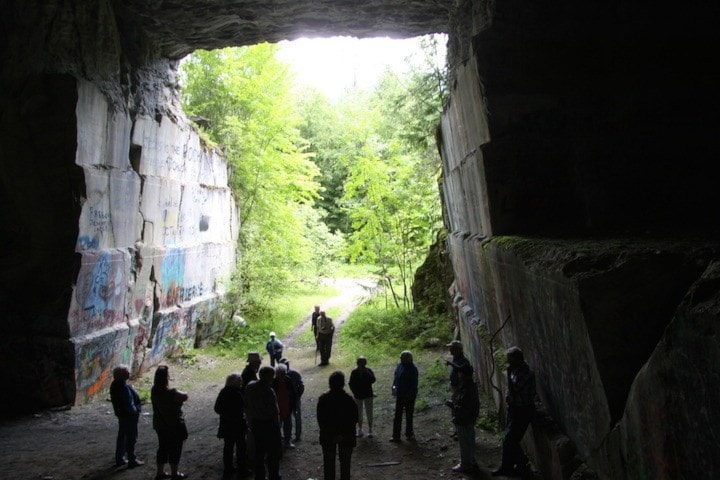One hundred nineteenth in an alphabetical series on West Kootenay/Boundary place names
Marblehead, in the Lardeau Valley, takes its name from the huge marble quarry there.
It was originally known as Leblanc (also spelled Lablanc, La Blanc, La Blanche and Le Blanche) after Alfred Leblanc (1853-1926), who by some accounts discovered the marble deposits with Jean Brochier. (Others say it was uncovered in 1899 when the CPR built its line through the area and that Ole Olsen of Lardo staked it.)
Leblanc was born in Quebec and as of 1901 operated the Ferry Hotel at the first crossing of the Lardeau River between Lardo and Howser. The CPR added Le Blanche to its timetable before September 1907 and by 1909 the Canadian Marble Works was operating there. According to The Kootenaian of Jan. 28, 1909: “Near LeBlanc, on the Lardo branch, exists a huge quarry of the finest marble …”
The place was renamed Marblehead later that year. The Winnipeg Tribune of Oct. 26, 1909 reported: “When a big diamond drill now on the way from Chicago arrives at the quarry at the Canadian Marble Works at Marblehead, BC in the course of a few days, everything will be ready for the thorough testing of one of the finest marble properties on the continent.”
Milt Parent wrote in Circle of Silver that “Gilman Barrows Wilson, an American, was in charge of the quarry in 1910 … A job sent him to all the marble producing states and provinces for the Patch Manufacturing Co. On this journey he visited LeBlanc … and became so interested in its potential that he bought the site and called it Marblehead.”
The earliest use of the name Marblehead, however, referred to a different site. The Kootenaian of Oct. 18, 1900 said: “The transfer of the Marblehead quarries, across the lake from Kaslo, to Ernest Mansfield, took place Wednesday.”
 Alfred Leblanc died near Howser and was buried in Kaslo. Marblehead’s name survives as a regional district transfer station and on the sign of Marblehead Automotive Service, an old cookhouse and recreation hall (seen at left).
Alfred Leblanc died near Howser and was buried in Kaslo. Marblehead’s name survives as a regional district transfer station and on the sign of Marblehead Automotive Service, an old cookhouse and recreation hall (seen at left).
The quarry itself, last operated in the late 1930s, remains an impressive sight. Its stone was used to build the Mormon temple at Cardston, Great West Life block in Winnipeg, and other noteworthy edifices.
In 1965, Marblehead was proposed as the name of a new post office at Meadow Creek. The director of postal services wrote: “Although the area in the immediate vicinity is known as Meadow Creek, it has been pointed out that the name would conflict with the existing post office of Meadow Lake, Sask.”
The Canadian Permanent Committee on Geographical Names, however, thought it would be more confusing to call a post office Marblehead that wasn’t actually at Marblehead, and pointed out other post offices existed across Canada at Meadow Portage, the Meadows, and Meadowvale without any problems.
Canada Post then suggested the name Duncan Dam, but the committee rejected it, saying it would cause confusion with Duncan on Vancouver Island. Postal officials relented and the Meadow Creek post office opened in 1967.
MAKINSONS LANDING
Three Canadian places are named for the Makinson family, but they’re about as far away from each other as you can get.
The earliest known mention of Makinsons Landing, 21 km southwest of Nakusp, is in the Slocan Mining Review of Jan. 24, 1907: “Jack Pratt left for Mackinson’s [sic] Landing again on Thursday, to join the lumberjacks.”
It was named for local farmer Thomas Cochrane Makinson (1870 – fl. 1915), who was born in Makinson, Nfld., in turn named after George Makinson, probably Thomas’ father, who arrived there from Liverpool around 1863.
Thomas married Margaret Tingley and they lived in Burton as of 1897 when their daughter Flora was born in Nakusp. A second daughter Aetta, arrived the following year, and a son, George, was born in Nakusp in 1903 before the family returned to Newfoundland.
George grew up to be an interesting guy. He worked as an entomologist and orchard inspector before joining the RCMP in 1923, and served in the arctic and western Canada. While stationed on Ellesmere Island in 1927-28 he discovered what became known as Makinson Inlet.
George later returned to Newfoundland to operate the family dairy farm and represented Port de Grave in the Newfoundland House of Assembly from 1949-51. He died in 1986.
A post office operated at Makinsons, BC from 1912 to 1960, but the community no longer exists. Makinsons, Nfld. no longer has a post office either, but still has a population of 438.
Previous installments in this series
Applegrove, Appleby, and Appledale revisited
Bakers, Birds, and Bosun Landing
Bannock City, Basin City, and Bear Lake City
Bealby Point (aka Florence Park) revisited
Boswell, Bosworth, Boulder Mill, and Broadwater
Brooklyn, Brouse, and Burnt Flat
Camborne, Cariboo City, and Carrolls Landing
Carmi, Cedar Point, Circle City, and Clark’s Camp
Carson, Carstens, and Cascade City
Christina City and Christian Valley
Cody and Champion Creek revisited
Champion Creek revisited, again
Columbia City, Columbia Gardens, and Columbia Park
Crawford Bay and Comaplix revisited
Dawson, Deadwood, and Deanshaven
English Cove and English Point
Forslund, Fosthall, and Fairview
Fort Shepherd vs. Fort Sheppard, Part 1
Fort Shepherd vs. Fort Sheppard, Part 2
Gladstone and Gerrard, revisited
Granite Siding and Granite City
Hall Siding and Healy’s Landing
Hudu Valley, Huntingtdon, and Healy’s Landing revisited
Inonoaklin Valley (aka Fire Valley)
Jersey, Johnsons Landing, and Jubilee Point
Kootenay Bay, Kraft, and Krestova
Kuskonook (and Kuskanax), Part 3
